We begin with the vast reserves of crude oil underground. Which we pump up for fuel. This is where diesel comes from that we run motors with to generate electricity. It is also where we get kerosene and heating oil to keep our homes warm. Crude oil is further refined to produce gasoline to run our cars, trucks, buses, boats, and more. Simply put we "burn" a lot of hydrocarbon fuel. Ever see those smoke stacks in the larger towns as you drive down the highway. That demonstrates how much smoke is released into the air. When it is whether from a large smoke stack or a small tailpipe it reacts with the vapor in the air creating acid rain. Which when it comes down seeps into the earth and reacts with the minerals. Most of the minerals in the Earth are based on silicates. A silicate is made of the elements silicon, oxygen, and a metal such as copper, aluminum, or iron. Acid rain with a low pH reacts with the different silicates and other minerals which have a higher pH. This releases some of the elements, helps to oxidize the compounds, and especially breaks them up into micronized particles of "rock". Hence the term "hard water".
The other day I came across an interesting situation. It was an existing construction site. The excavation was done about two years ago. But you can see the degree of discoloration that was done to the holding wall by the runoff of rain water that had reacted with the iron based silicates in the broken rock setting just above the wall. Obviously the silicates are iron based because the stain is red. In the picture I took of the wall you can plainly see how the rain runs down over the wall every time it rains. Once the rain dries the stain is left behind. It is an interesting note that the minerals are not all based on iron. I have included a closeup of a small rock where you can see other colors besides red. So these other minerals also are included.
In the above picture you can see all of the broken flat rock carrying the iron silicate that has been leached by acid rain and deposited over the outside of the stone retaining wall. Not too pretty. Likely it was not expected either.
This is an up close picture of the stain.
Here we can see where most of the rain is coming down from. Also it is quite plain that the red stain is from the broken excavation rock, and in particular the iron silicates. But I am sure if you did a spectrographic analysis you would also find aluminum, copper, manganese, and other metals.
What is very interesting is how quickly this staining problem developed. One to two years. It forms on glass windows by means of sprinkler systems. The minerals react with the rain that seeps into the ground. As it passes through the dirt and sand it reacts with the rocks there. Becoming loaded with the dissolved rock. And collects in the wells. Which is then used for the sprinklers. That end up watering both the grass and the glass. The end result is red windows. Including the aluminum framework as well. Different minerals yield different colors. Especially on Low e first surface metallic hardcoats. The effect is not appreciated. But it can be quite beautiful! It can look like a huge bright multicolored rainbow!!
I have a nice gallery of hard water stained glass here. And am collecting more from around the world. So bookmark this blog and keep a watch on the right column.
Written by Henry Grover Jr.
GlassSmart@ProtonMail.com





No comments:
Post a Comment